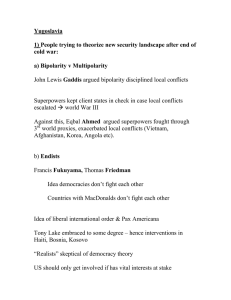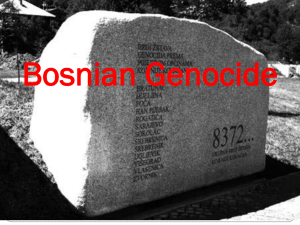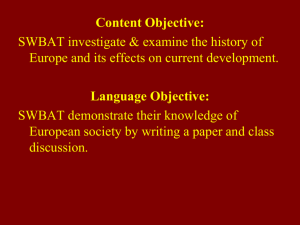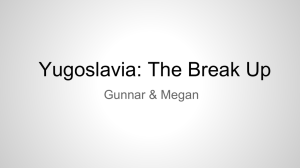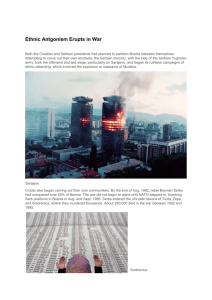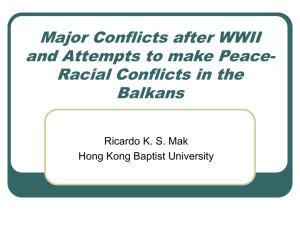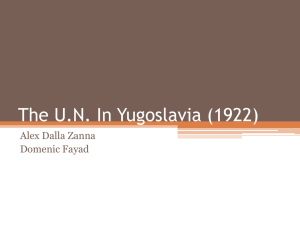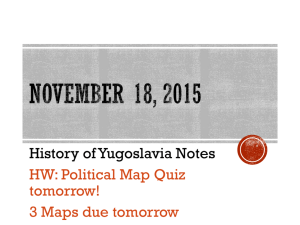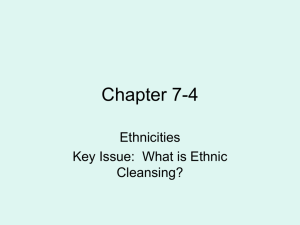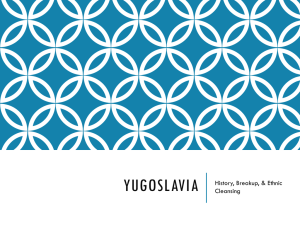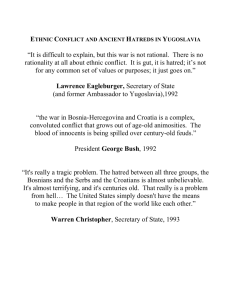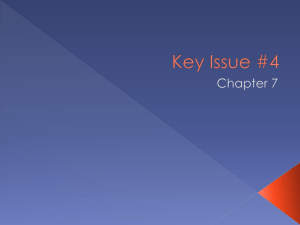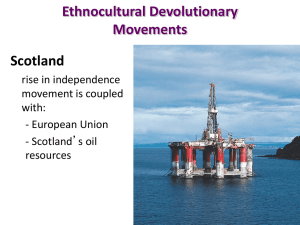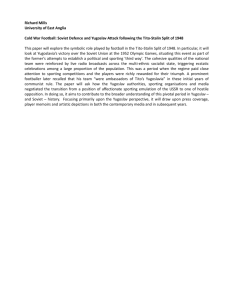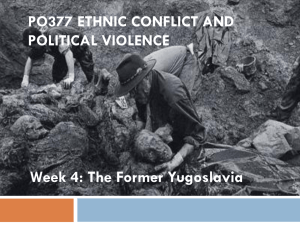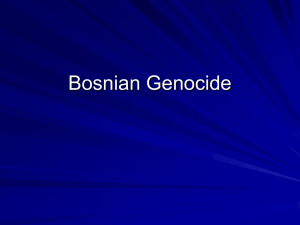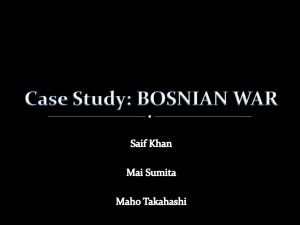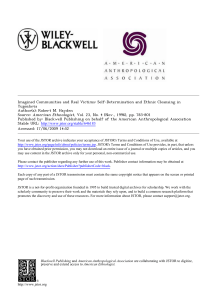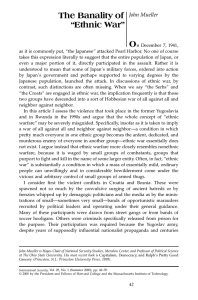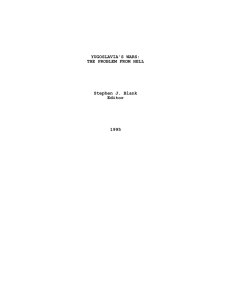Yugoslav Conflict
advertisement
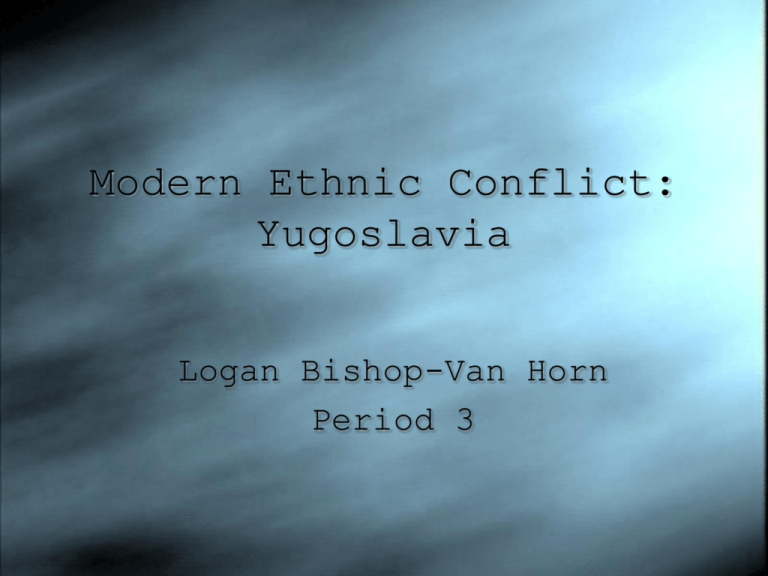
Modern Ethnic Conflict: Yugoslavia Logan Bishop-Van Horn Period 3 Roots of Conflict The conflicts in former Yugoslavia can be traced back to before the founding of the country (then the Kingdom of Serbs, Croats, and Slovenes) in 1918. The three peoples were somewhat forced together. The Serbs had by far the most power among the three groups. The Croatians felt that they were being exploited by the relatively small (40% of population), but powerful Serbs. World War II Nazi occupation of Yugoslavia beginning in WWII in both divided and united the country. Serbo-Croatian conflict was intensified, but anti-German sentiment extended beyond nationalism. Led by a powerful new Communist, the Yugoslavs revolted against the Nazis in the early 1940s. This led to 800,000 German deaths. However, 350,000 Yugoslavs (mostly Croatians) perished as well. Adolf Hitler and Prince Paul of Yugoslavia during the destructive Nazi occupation of World War II. Tito’s Rule Marshal Josip Tito assumed power in Yugoslavia in the mid 1940s. He was a very strong leader. After driving the Nazis out of Yugoslavia, he made the country into a Communist state comprised of six republics. In the 1960s and ‘70s, backlash against the repressive police force led to outbursts of nationalism in two of the six republics: Kosovo and Croatia. Tito’s powerful personality, however, temporarily contained any real revolts. Overwhelming Nationalism In 1980, Tito died, leaving the country without the strong, if repressive, leader it so badly needed. Near the end of the 1980s, tensions in Kosovo were reaching a boiling point. Slobodan Milosevic emerged as a strong voice for Serbian nationalism and became the leader of the Yugoslav government. Under Milosevic’s rule, the country became increasingly dominated by Serbs. Disintegration In early 1990, Communist parties were voted out of power in Slovenia and Croatia. The predominantly Croat voters in Croatia favored a confederate government. This triggered backlash from the 600,000 Serbs in the republic. Serbs began to organize militias and declare autonomy from Croatia. Disintegration In 1991, Western countries began encouraging both Slovenia and Croatia to secede from Yugoslavia. When Slovenia and Croatia both declared independence on June 25, 1991, war broke out between the republics and the government. Civil war in Slovenia was relatively brief, but the Yugoslav government and Serb forces worked together to fight Croatia. Croatia’s War of Independence. Bosnian Independence In February 1992, the government held a vote on Bosnian independence from Yugoslavia. Serbs solidly opposed independence (because the Yugoslav government was largely Serbian), while both Croats and Muslims (Bosniaks) strongly supported it. Bosnia soon declared its independence, and the U.N. deployed peacekeeping efforts. Bosnian Serbs, upset at their independence, quickly organized militias, which were supplied heavily by the Yugoslav government. Bosnian Conflict The Bosnian Conflict, which lasted more than three years, was essentially Croats and Bosniaks united against Serbs and the Serb-run Yugoslav government. (By 1993, Yugoslavia had gone from six republics to two: Serbia and Montenegro.) The war involved some violence between Croats and Bosniaks, even though they were originally united against the Serbs. Bosnian Conflict Fighting included civilian shelling, the arming of extremist militias, the use of rape as a weapon, and ethnic cleansing resulting in mass graves. The large city of Sarajevo became a city of murder, its citizens were forced to live underground in fear of snipers. Bosnian Conflict Fighting included civilian shelling, the arming of extremist militias, the use of rape as a weapon, and ethnic cleansing resulting in mass graves. The large city of Sarajevo became a city of murder, its citizens were forced to live underground in fear of snipers. The Sehidska Cemetery, final resting place of more than 11,000 soldiers killed in the conflict. Civilians duck to avoid sniper fire at a peace march in Sarajevo in 1992. Rape As a Weapon Systematic mass rape was a common tool of terror in the Bosnian conflict. Women of all ethnicities were subject to the atrocity, but the Serb armed forces were responsible for most. According to estimates, anywhere from 20,000-60,000 Bosnian women were raped. Only twelve of these cases have been prosecuted. The affects, both emotional and physical, are still manifesting themselves in Bosnian women today. As Bosnia-Herzegovina works to recover as a new nation, the country is facing the children born as a result of the brutality. Global Peacekeeping Efforts The UN frequently went into combat, attempting to arrange cease-fires between the two sides. At other times, the UN peacekeeping forces were simply outgunned and powerless in stopping the genocide. Countless peacekeeping efforts came and went, but none were able to stop the violence. NATO Intervention Finally, the North Atlantic Treaty Organization (NATO) was able to deploy enough military power to slow the violence enough for diplomacy to act. In 1995, 60,000 NATO troops were deployed to Bosnia to preserve an October 6 cease-fire. On November 21, the Dayton Agreement went into effect and both sides agreed to solve disagreements peacefully. The conflict in former Yugoslavia can be used as evidence in both the case for Bowen’s “Myth of Ethnic Conflict” argument and Huntington’s “Clash of Civilizations” theory. There is no doubt that the root of the conflict was ethnic identity, an “if you aren’t us, you’re against us” mentality. However, the conflict would not have escalated to the point that it did if it weren’t for the role of the Yugoslavian government. They essentially funded the ethnic cleansing of Bosniaks by Serbs. Other countries irresponsibly encouraged Croatia and Bosnia to secede from Yugoslavia without providing them the support they needed. In the end, an estimated 200,000 people died in the disintegration of Yugoslavia. Tens, if not hundreds, of thousands more were scarred for life emotionally, physically, or both. Even today, social and political tensions live on, particularly in Bosnia-Herzegovina, where Bosniaks are trying to rebuild after having nearly been wiped out. Despite peacekeeping and rebuilding efforts from all over the world, Bosnia-Herzegovina is still a country deeply divided along ethnic lines and hurting from its years of civil war and genocide. Bibliography "Bosnia and Herzegovina." CIA - The World Factbook. CIA, 7 Dec. 2010. Web. 8 Dec. 2010. <https://www.cia.gov/library/publications/the-worldfactbook/geos/bk.html>. "GENOCIDE - BOSNIA." Peace Pledge Union. Peace Pledge Union, n.d. Web. 14 Dec. 2010. <http://www.ppu.org.uk/genocide/g_bosnia.html>. Gerbet, Pierre. "The Yugoslav conflict." The history of a united Europe on the Internet. European NAvigator, n.d. Web. 11 Dec. 2010. <http://www.ena.lu/yugoslav_conflict-020102257.html>. "ICTY - TPIY :: The former Yugoslavia - Conflicts." ICTY - TPIY. UN, n.d. Web. 10 Dec. 2010. <http://www.icty.org/sid/322>. Rudolph, Joseph R.. "Yugoslavia: The Deconstruction of a State and Birth of Bosnia." Encyclopedia of modern ethnic conflicts . Westport, Conn.: Greenwood Press, 2003. 349-357. Print. Sowards, Steven W.. "The Yugoslav Civil War." MSU Libraries Staff Pages. Michigan State University, 27 Nov. 1996. Web. 3 Dec. 2010. <http://staff.lib.msu.edu/sowards/balkan/lect25.htm>.
